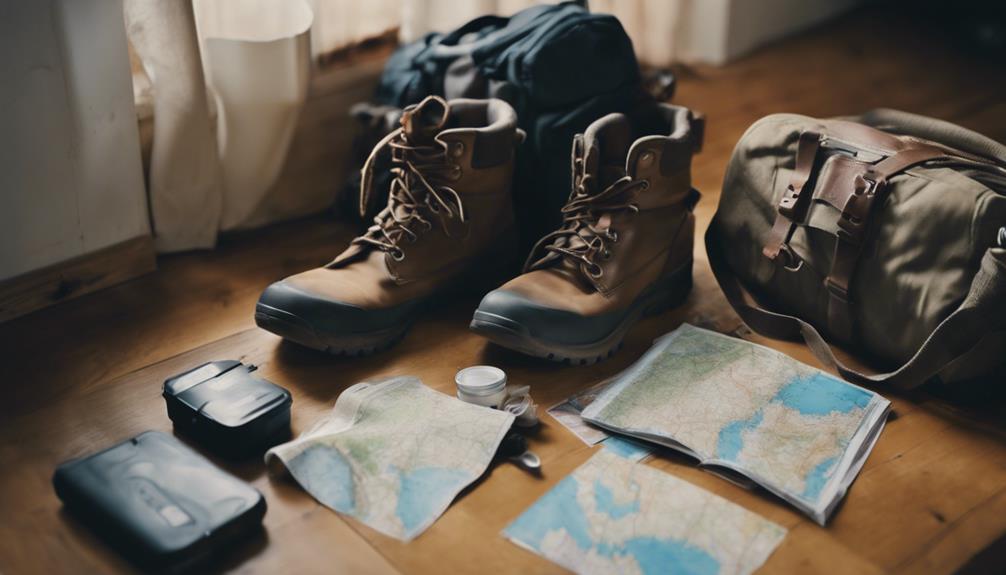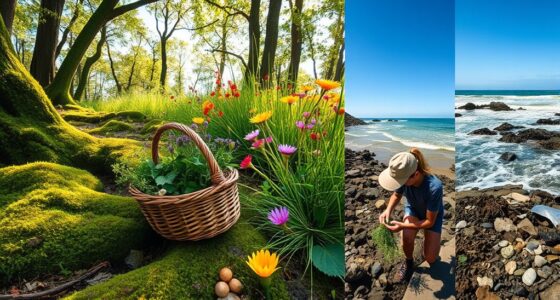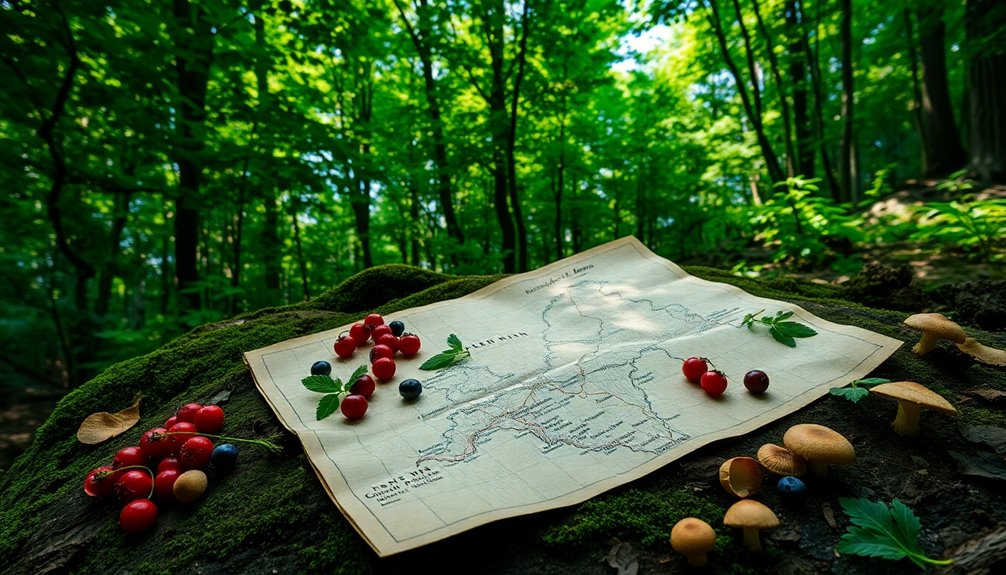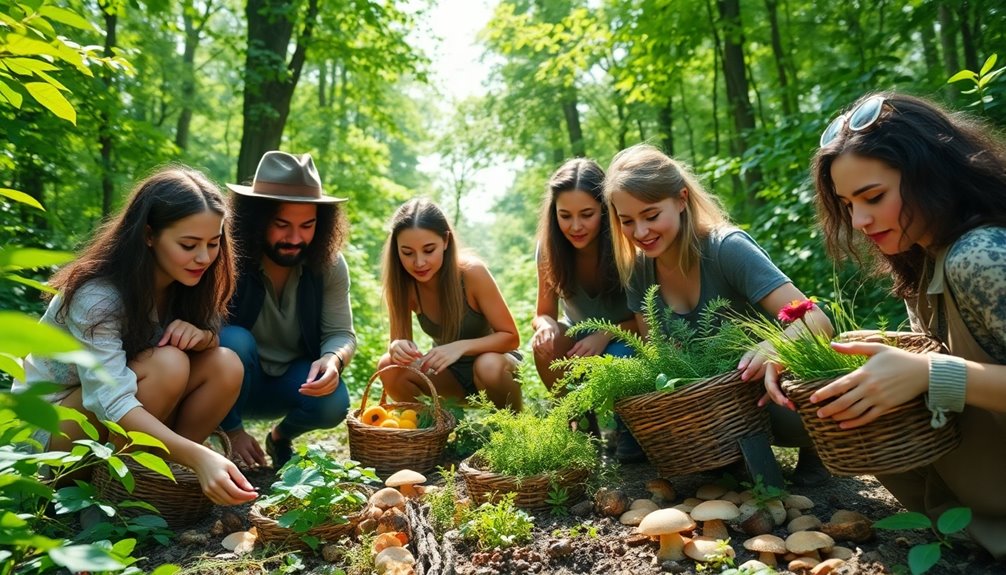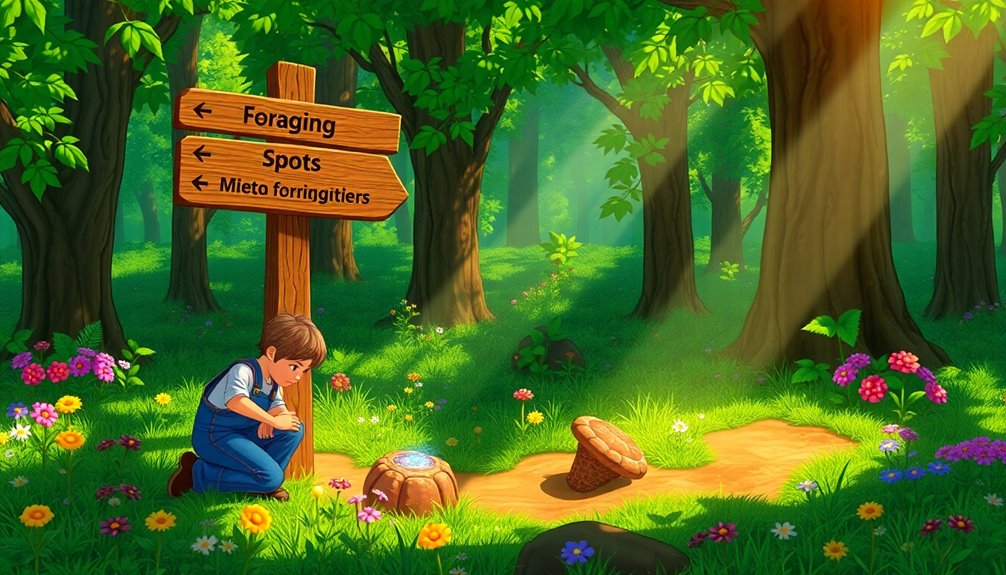Prepare for your upcoming foraging excursion by first familiarizing yourself with local regulations and the protection of endangered species. Afterwards, learn how to identify edible plants, taking into account seasonal changes and potential toxic look-alike species. Arm yourself with necessary tools such as field guides, gloves, and containers. Dress appropriately in layers for the weather and wear sturdy footwear. Take only what you require and show respect for the delicate balance of nature. Discover wild greens, berries, and fruits while avoiding dangerous counterfeit plants. Prioritize safety by educating yourself on plant characteristics and seeking guidance from local experts, especially in urban environments. Keep in mind that proper preparation will set you up for a successful foraging adventure ahead.
Key Takeaways
- Research local foraging laws and regulations.
- Identify edible plants and toxic look-alikes.
- Dress in appropriate attire and gear.
- Practice sustainable harvesting methods.
- Prioritize safety by washing foraged items and avoiding pollution.
Know Local Foraging Laws
Before heading out on a foraging expedition, make sure you know the local foraging laws to avoid legal complications. Understanding the foraging laws and regulations in your area is vital to guarantee you're harvesting plants ethically and legally.
Some regions have specific guidelines regarding protected species, harvest limits, and restricted areas. By familiarizing yourself with these regulations, you can identify what plants are permissible to harvest, where you can harvest them, and any restrictions that may apply.
Violating foraging laws can lead to fines, penalties, or harm to the environment and wildlife populations, so it's essential to comply with the rules in place. To stay informed, consider checking with local authorities, land management agencies, or foraging groups for the most up-to-date information on relevant regulations.
Identify Edible Plants
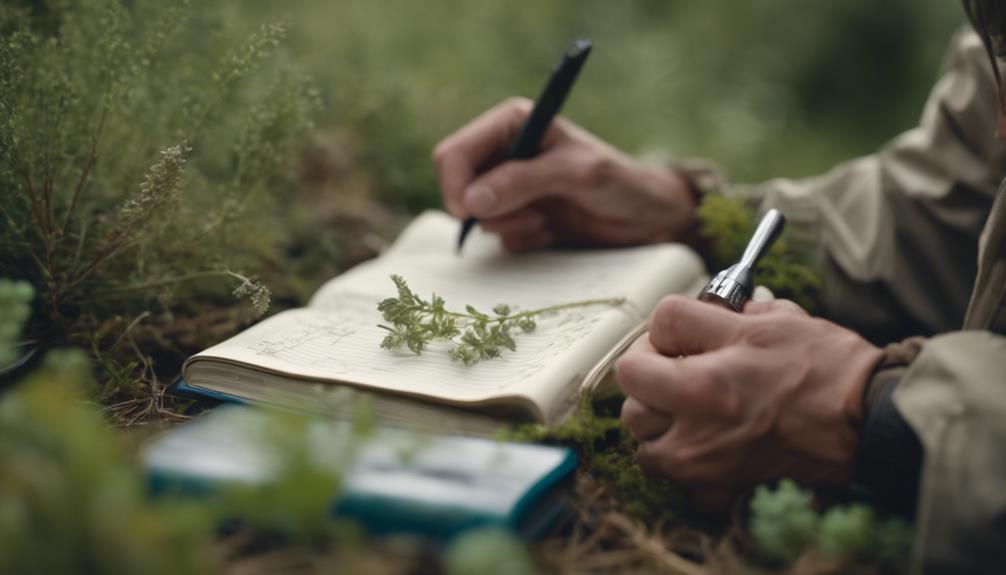
To successfully identify edible plants, start by familiarizing yourself with key characteristics like leaf shapes, stem textures, fruit colors, and growth habits.
Understanding the seasonal availability of different plants is essential for effective foraging, as some species may be toxic at certain times of the year.
Plant Identification Techniques
When identifying edible plants for foraging, pay close attention to key features like leaves, stems, fruits, and growth patterns to guarantee accurate recognition. Understanding these distinguishing characteristics is essential to differentiate between edible plants and their potentially harmful look-alikes, ensuring foraging safety. Common edible plants like dandelions, cattails, berries, and wild mushrooms offer a rich source of nutrients when correctly identified.
To aid in plant identification, below is a table summarizing key features to look for:
| Feature | Description |
|---|---|
| Leaves | Note color, shape, texture, and any unique markings. |
| Stems | Consider thickness, height, and any distinct patterns. |
| Fruits | Examine size, color, arrangement, and presence of any spikes or hairs. |
Misidentification of plants can have severe consequences, so take the time to learn to identify unique plant species in your area. This knowledge not only enhances your foraging experience but also boosts your safety in the wild.
Seasonal Availability Considerations
Taking into account the seasonal availability of edible plants is vital for successful foraging expeditions. Different seasons present varying opportunities for foragers, with spring offering wild greens, summer providing berries and fruits, autumn known for nuts and mushrooms, and winter yielding cold-hardy plants.
By understanding these seasonal variations in edible plant availability, foragers can strategically plan their expeditions to maximize success. Plant identification plays an important role in this process, as knowing when specific plants are in season enhances foraging efficiency.
Adapting foraging trips to seasonal changes guarantees a diverse range of edible plants can be harvested throughout the year. Therefore, staying attuned to the shifts in seasonal availability and honing your plant identification skills are key steps in preparing for a fruitful foraging experience.
Safety Precautions Reminder
Properly identifying edible plants before foraging is essential for guaranteeing your safety in the wild. When preparing for a foraging expedition, remember that accurate identification of edible plants is fundamental to prevent any potential risks. Look for distinguishing features like leaves, stems, fruits, and growth patterns to differentiate between edible and toxic plants.
While common edible finds include dandelions, cattails, berries, and wild mushrooms, it's important to stay vigilant as unique species may exist in your foraging area. If there's any doubt about a plant's safety, refrain from consuming it to avoid poisoning.
In urban settings, be cautious as green spaces might've been treated with pesticides, which can be harmful if ingested. Remember to wash foraged foods thoroughly before consumption to eliminate any contaminants. Prioritizing safety precautions when identifying edible plants will ensure a successful and risk-free foraging experience.
Gather Essential Tools
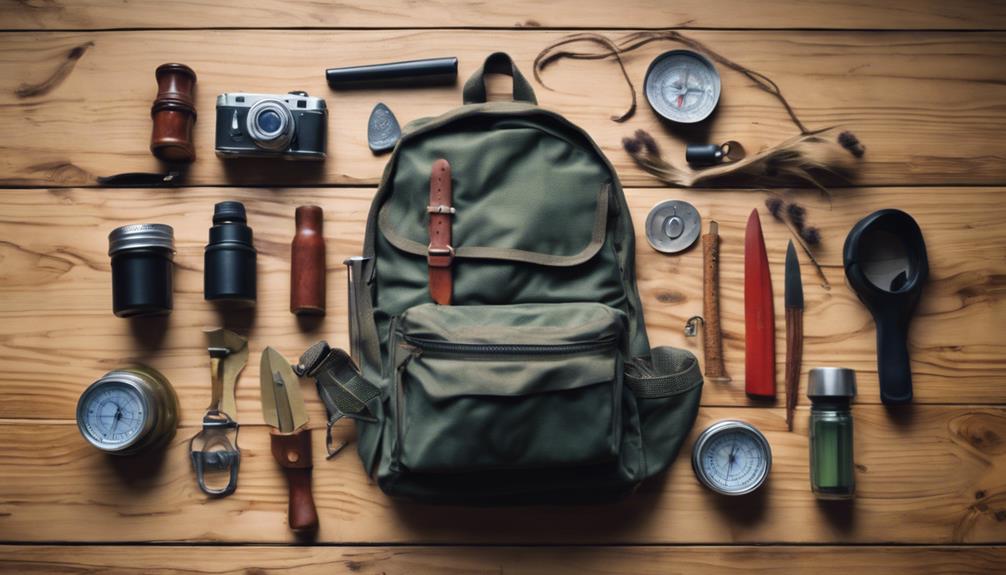
Make sure you have all the necessary tools ready before starting your foraging adventure. A field guide is essential for accurate identification of wild plants that you come across. This will help you distinguish between edible treasures and potentially harmful species.
Remember to bring a container or basket for collecting your foraged items without causing damage. Leather gloves are a must-have to protect your hands while harvesting plants in the wild. Additionally, consider carrying a knife or scissors for safely cutting and gathering plants. These tools won't only aid in harvesting but also guarantee you can do so without harming the environment.
Equip yourself with hiking gear like a daypack and proper footwear to guarantee a comfortable foraging experience. Being well-prepared with the right tools won't only enhance your foraging expedition but also contribute to a safe and enjoyable outing in nature.
Dress Appropriately
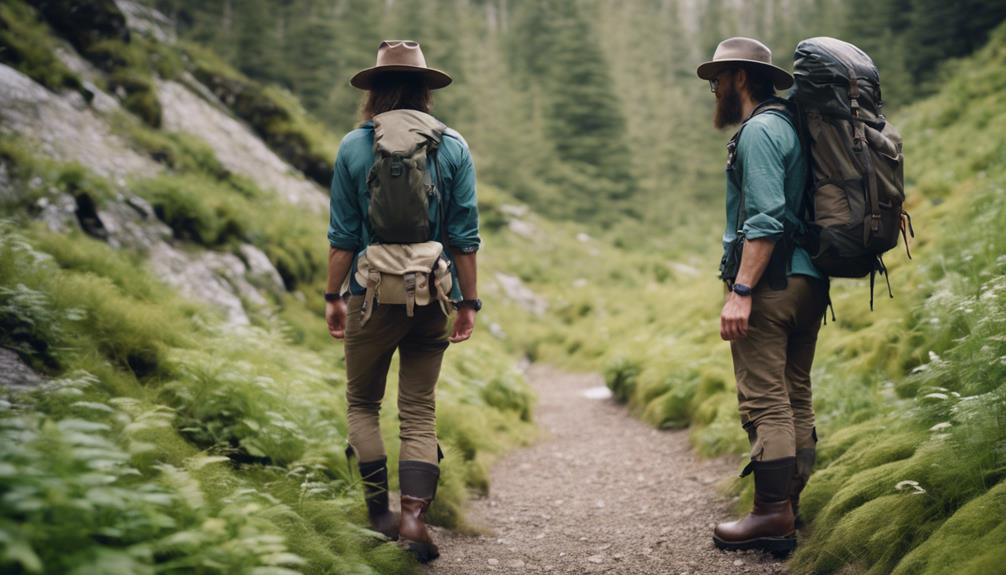
When preparing for a foraging expedition, it's essential to dress appropriately for the occasion. This includes choosing suitable clothing options, considering the right footwear for varying terrains, and being mindful of weather conditions.
Ensuring you're well-equipped with the right attire will help you stay comfortable and safe throughout your foraging adventure.
Suitable Clothing Choices
Choose appropriate clothing for your foraging expedition by prioritizing protection, comfort, and practicality. When venturing into the wilderness to gather wild greens, identify mushrooms, and avoid poisonous plants, your clothing choices can make a significant difference in your foraging experience.
Follow these tips to make sure you're properly outfitted:
- Wear Protective Layers: Opt for long sleeves and pants to shield your skin from scratches, insect bites, and contact with irritant plants. This will help keep you safe and comfortable during your foraging adventure.
- Choose Breathable Fabrics: Select lightweight materials that allow air circulation to prevent overheating while trekking through the forest. Staying cool and dry will enhance your overall comfort and enjoyment.
- Sturdy Footwear: Invest in closed-toe shoes or boots with excellent traction to navigate rough terrain and safeguard your feet from potential hazards. Proper footwear is essential for a successful foraging trip.
Footwear Considerations
Select sturdy and comfortable footwear with good traction to navigate various terrains effectively during your foraging expeditions. When foraging for wild edibles, having the right footwear is important for your safety and comfort.
Experienced foragers understand the importance of choosing waterproof or water-resistant shoes to keep your feet dry when exploring damp environments. Opt for closed-toe shoes to shield your feet from sharp objects, thorns, or potential insect bites commonly encountered in the wild.
In addition to protection, your footwear should offer ample support and cushioning to prevent fatigue and injuries during long foraging trips. A good pair of shoes not only keeps you comfortable but also enhances your agility, allowing you to move confidently through different landscapes.
Weather-Appropriate Attire
Dressing appropriately for the weather is vital to guarantee your comfort and safety during your foraging expedition. Here are some key points to contemplate when selecting your attire:
- Dress in Layers: The weather in the wild can be unpredictable, so dressing in layers allows you to adjust to changing conditions easily. This way, you can stay comfortable and regulate your body temperature effectively while exploring for plants.
- Wear Moisture-Wicking Clothing: Opt for moisture-wicking fabrics to keep dry and comfortable throughout your foraging adventure. This type of clothing helps to manage sweat and moisture, preventing chafing and potential discomfort while you search for wild plants.
- Choose Sturdy Footwear: Select closed-toe shoes with good traction to navigate various terrains safely. Sturdy footwear is crucial to protect your feet from potential hazards and ensure stability as foragers can make mistakes while walking on uneven ground.
Practice Sustainable Foraging
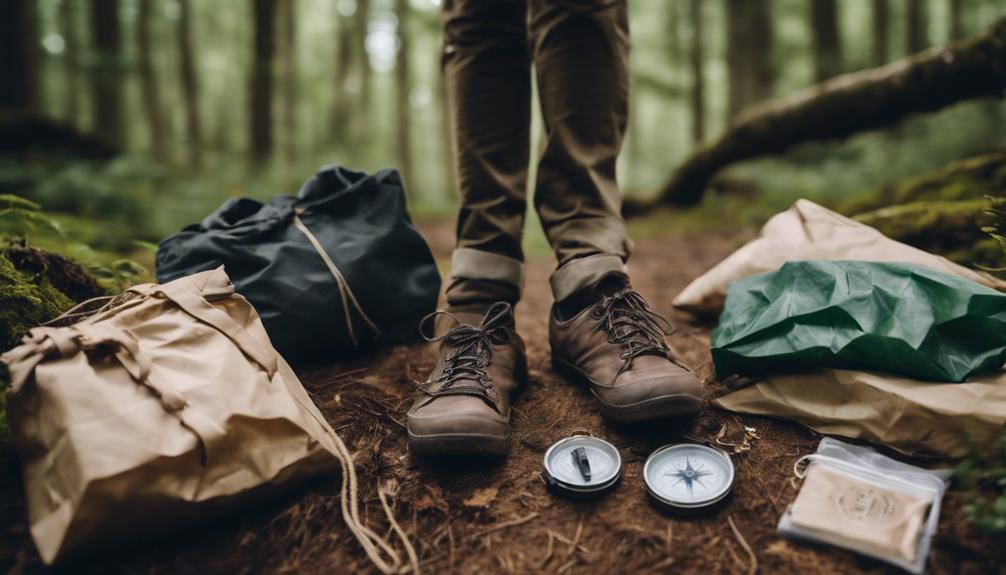
To thrive in foraging while preserving natural resources, prioritizing sustainability is essential. Sustainable foraging involves adhering to ethical guidelines and responsible harvesting practices. It requires taking only what you need, leaving some for wildlife and future foragers, and respecting the local ecosystem.
Understanding the reproductive patterns of plants and their growth habitats is pivotal to guarantee sustainable harvesting practices. By following ethical guidelines and harvesting practices, foragers can minimize their impact on plant communities and promote biodiversity. Responsible foraging not only helps protect the environment but also ensures the longevity of wild plant populations for future generations.
Sustainable foraging practices include respecting landowner permissions, avoiding over-harvesting, and actively participating in conservation efforts. By practicing sustainable foraging, you play a critical role in preserving natural resources and maintaining the delicate balance of the ecosystem for all to enjoy.
Learn Mushroom Varieties
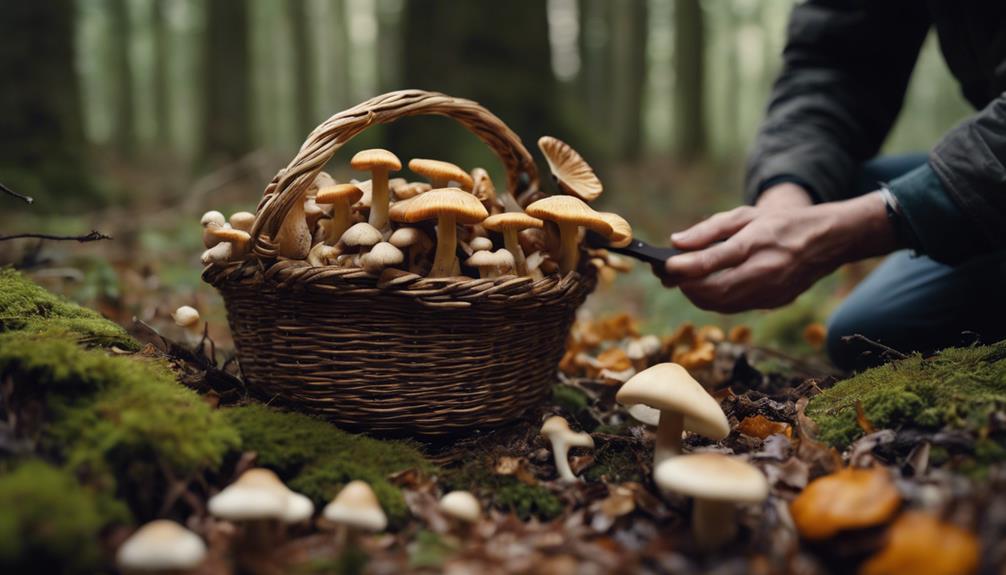
To prepare for your foraging expedition, it's essential to learn about mushroom varieties. By understanding the characteristics of edible mushrooms like chanterelles and morels, you can confidently identify safe options in the wild.
Avoiding toxic varieties and seeking expert guidance will help you navigate the intricate world of mushroom foraging successfully.
Identify Edible Varieties
Learn to distinguish common edible mushroom varieties like chanterelles, morels, porcini, and chicken of the woods by studying their key characteristics. These wild mushrooms are sought after for their culinary value and are prized foraged foods.
To identify edible varieties effectively, consider the following:
- Chanterelles: Look for their distinctive trumpet or funnel-shaped caps, which range in color from yellow to orange. Chanterelles have gills that run down the stem and a fruity aroma.
- Morels: Recognize these mushrooms by their honeycomb-like caps and hollow, cone-shaped stems. Morels can vary in color from light yellow to dark brown and are often found in wooded areas.
- Porcini: Identify porcini mushrooms by their large, brown caps and thick stems. These mushrooms have a meaty texture and a nutty flavor, making them a popular choice for cooking.
Avoid Toxic Mushrooms
Identifying common toxic mushroom varieties is vital for your safety during foraging expeditions. Toxic mushrooms like Amanita phalloides (Death Cap) and Gyromitra esculenta (False Morel) can have severe consequences if consumed.
To avoid poisoning, it's important to learn to differentiate toxic mushrooms from edible ones based on color, shape, odor, and habitat. Understanding the potential lethal effects of consuming toxic mushrooms, such as organ failure and death, underscores the importance of this knowledge.
Consulting experienced mycologists or foragers can enhance your understanding of toxic mushroom varieties and further reduce the risk of accidentally consuming them. Remember, it's better to err on the side of caution and avoid consuming any wild mushroom unless you're 100% certain of its safety.
Seek Expert Guidance
Enlisting the help of knowledgeable foragers or mycologists can greatly enhance your understanding of different mushroom varieties and their distinguishing characteristics. Learning from experts in the field of mycology is vital for a safe and successful foraging experience.
Here are three key ways to expand your knowledge:
- Attend Workshops and Classes: Participating in mushroom identification workshops and foraging classes can provide hands-on experience and practical skills in distinguishing between edible and poisonous mushrooms.
- Join Mycological Societies: Connecting with local mycological societies or clubs allows you to network with experienced foragers who can offer valuable insights and guidance on safe foraging practices.
- Utilize Resources: Make use of field guides, mushroom identification apps, and online resources to familiarize yourself with the diverse range of mushroom species in your area. Understanding the key features of mushrooms, such as cap shape, gills, spore print color, and habitat preferences, is essential for accurate identification during your foraging expeditions.
Explore Edible Greens
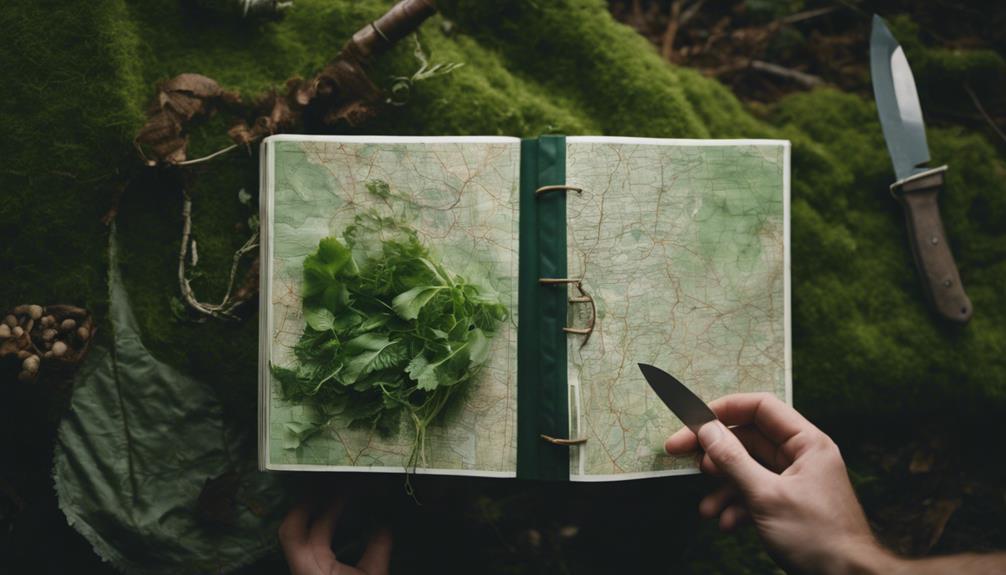
As you commence your foraging expedition, take the time to discover the array of flavors and nutrients offered by edible greens found in nature. Dandelion greens, a common choice for foragers, aren't only important to eat but also packed with vitamins A, C, and K, as well as calcium and iron. These greens have a slightly bitter taste that can add depth to salads or be sautéed with garlic for a nutritious side dish.
When foraging for edible greens, remember to carefully identify them based on their unique characteristics to avoid any potential lookalikes that may be toxic.
Exploring edible greens such as wild lettuce, chickweed, lambsquarters, and purslane can introduce you to a world of diverse tastes and culinary possibilities. Before harvesting, make sure you only take what you need, leaving some for wildlife and future foragers to enjoy. Properly washing and preparing these greens is important to eliminate any dirt, insects, or contaminants, ensuring a safe and enjoyable foraging experience.
Discover Berries and Fruits
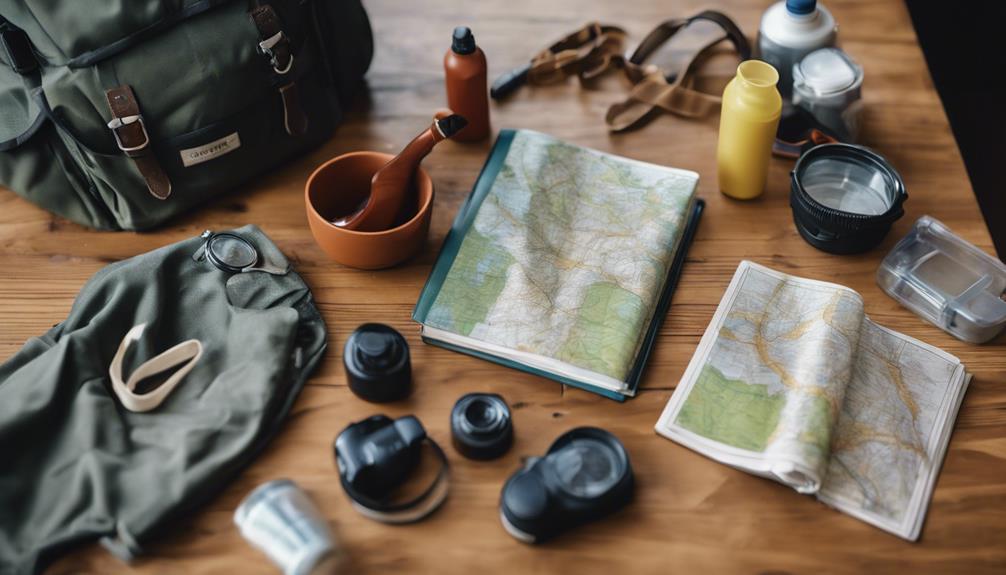
When foraging in nature, exploring the diverse array of wild berries and fruits can provide you with a rich source of nutrients and flavors.
Nutrient-Rich Foods: Wild berries and fruits are abundant in essential nutrients like vitamins, antioxidants, and fiber, offering a healthy boost to your diet.
Variety of Options: Examples of wild berries and fruits you might encounter include blackberries, blueberries, raspberries, strawberries, apples, and pears, each offering a unique taste and nutritional profile.
Versatile Use: These berries and fruits can be enjoyed fresh while foraging or incorporated into various recipes. Additionally, they can be preserved through methods such as freezing, drying, or making jams, allowing you to enjoy their goodness even after your foraging expedition.
Remember to always be cautious of poisonous lookalikes when harvesting wild berries and fruits, and understanding the seasonal availability of different varieties can help you plan your foraging trips effectively.
Avoid Poisonous Lookalikes
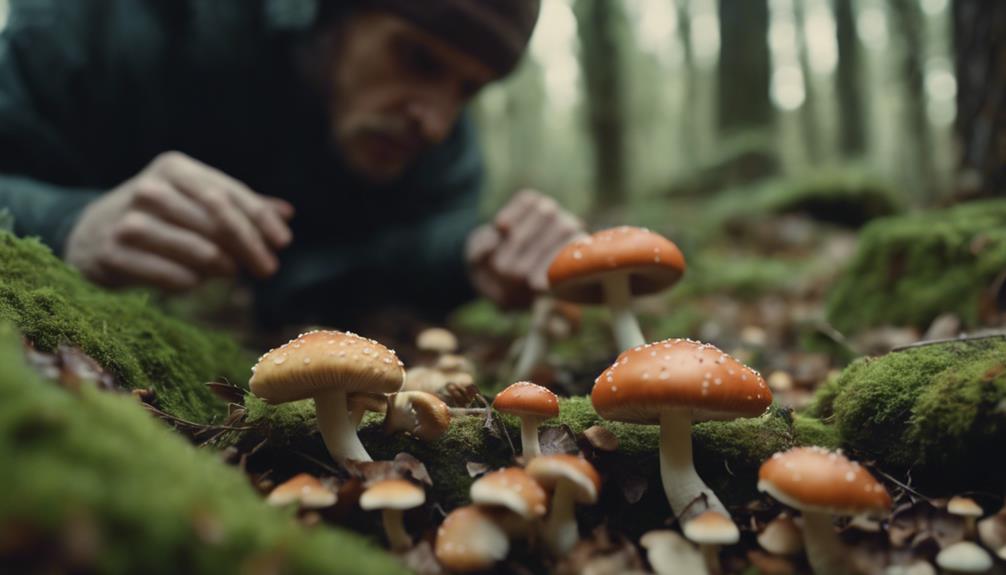
Being vigilant in discerning between edible plants and their poisonous lookalikes is essential for a safe foraging adventure. Accurate identification of potential toxic plants is vital as many poisonous lookalikes closely resemble their harmless counterparts, leading to potential illness or discomfort if consumed.
For example, deadly nightshade bears a striking resemblance to blueberries, while water hemlock can be mistaken for wild carrots. To avoid these dangers, foragers must pay careful attention to distinguishing features such as leaf shape, flower color, and growth patterns.
Researching and studying the distinguishing characteristics of poisonous lookalikes before starting on a foraging trip is key to preventing hazardous mistakes. By familiarizing yourself with the unique traits of both edible plants and their toxic counterparts, you can guarantee a safer and more successful expedition.
Forage Safely in Urban Areas
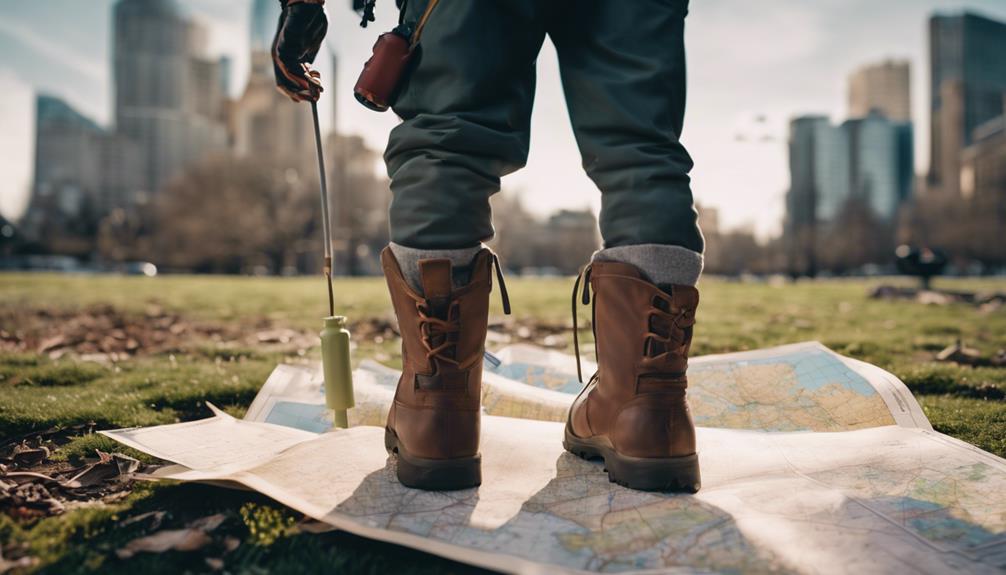
To forage safely in urban areas, it's important to be aware of the potential risks and rewards of harvesting wild edibles amidst city environments. Urban foraging can be a fruitful endeavor, but it comes with unique challenges.
Here are some key tips to help you navigate urban foraging safely:
- Understand Urban Foraging: Urban areas can offer a diverse range of wild edibles like dandelions, purslane, and chickweed. However, be cautious of pollution and pesticide exposure when foraging in urban green spaces.
- Connect with Local Foraging Groups: Joining local foraging groups or seeking advice from experts can provide valuable insights into safe foraging practices in urban settings. They can help you identify edible plants and avoid potentially harmful ones.
- Wash and Clean Thoroughly: Always remember to wash and clean any foraged urban plants meticulously. This step is vital to remove any contaminants that may be present due to urban environmental factors.
Frequently Asked Questions
What Are the Steps of Foraging?
To forage effectively, research local edible plants, consult guides, understand seasons, learn plant ID, and gather tools. These steps guarantee a successful foraging trip. Prepare well to enjoy the bounty of nature safely.
What Is the Golden Rule of Foraging?
When foraging, remember the golden rule: never eat anything unless you're 100% sure it's safe. It's essential for your health. Avoid ingesting unknown items to prevent poisoning. Stay safe, always.
What Should You Know Before Foraging for Food in the Wild?
Before foraging for food in the wild, know local edible plants and their characteristics for safe identification. Expand knowledge through guides or experienced foragers. Understand seasonal availability, proper preparation, and responsible foraging practices.
What Is Foraging Strategies?
Foraging strategies seek success in gathering wild edibles. Equip yourself with knowledge of plants, environment, and seasons. Research locations, practice sustainable harvests. Plan for safe and fruitful expeditions, minimizing risks while maximizing rewards.
Conclusion
To sum up, proper preparation is crucial for a successful foraging expedition. By knowing local laws, identifying edible plants, gathering essential tools, dressing appropriately, practicing sustainability, exploring greens and fruits, and avoiding poisonous lookalikes, you can guarantee a safe and enjoyable foraging experience.
Remember to forage responsibly and respect your surroundings to continue enjoying the benefits of this ancient practice. Happy foraging!

